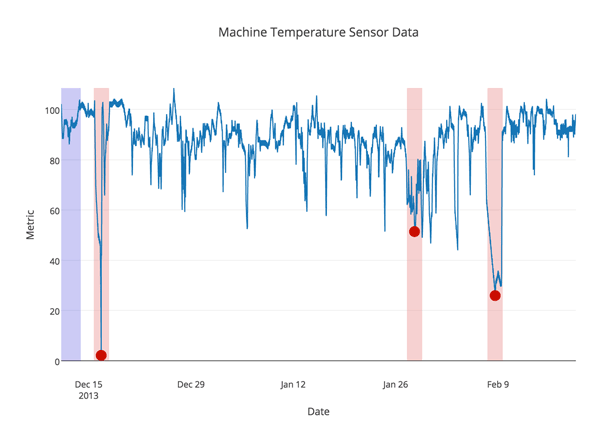| Authors | S. Ahmad, A. Lavin, S. Purdy, & Z. Agha |
| Journal | Neurocomputing (2017) |
| Online | Read or Download this Paper |
| Published | June 2, 2017 |
Across every industry, we are seeing an increase in the amount of streaming, time-series data produced by connected real-time data sources. Deriving value from these streams requires modeling each one in
an unsupervised fashion to detect anomalies in real time. This has practical and significant value – from using medical sensors to know when a patient is in distress to uncovering a bottleneck in your IT infrastructure. Most people agree that detecting real-time anomalies is important, but it’s also difficult to achieve. It requires anomaly detection systems that process data in real-time as opposed to batches, learn continuously and are fully automated. This paper demonstrates how Numenta’s online sequence memory algorithm, Hierarchical Temporal Memory (HTM), meets those requirements. The paper also presents results using the Numenta Anomaly Benchmark (NAB), the first open-source benchmark
designed for testing anomaly detection algorithms on streaming data.

This data stream from NAB represents machine temperatures recorded
over time. Anomalies are marked by a red circle within the pink
shaded anomaly windows.
Frequently asked questions about this research
Q. What was the purpose of this paper?
The purpose of this paper is to highlight the importance of anomaly detection for streaming applications and introduce two contributions within that field. The first is a novel unsupervised anomaly detection technique using Hierarchical Temporal Memory (HTM), a theoretical framework for sequence learning in the cortex. The second is the Numenta Anomaly Benchmark (NAB). The benchmark, the first of its kind, provides a controlled open-source environment for testing anomaly detection algorithms on streaming data. We analyze the characteristics of an ideal detector and articulate how HTM displays those characteristics. We then analyze the performance of ten algorithms (including HTM) on NAB. We discuss future challenges for the emerging field of streaming analytics.
Q. What are the key takeaways?
- Anomaly detection represents one of the most significant applications for machine learning in IoT
- Because of the unique characteristics of streaming data applications, the ideal streaming anomaly detector should meet a set of requirements:
- Predictions must be made online; they cannot look ahead
- Algorithms must learn continuously
- Algorithms must run unsupervised and automatically
- Algorithms must adapt to dynamic environments
- Algorithms should make anomaly detections as early as possible
- Algorithms should minimize both false positives and false negatives
- Though HTM was not created specifically for anomaly detection, because HTM implementations operate in real-time and work well for prediction tasks, this approach can yield good results when applied to streaming anomaly detection
- NAB provides a way to evaluate streaming anomaly detection algorithms. It contains a dataset with real-world, labeled data streams, a scoring methodology that rewards early detection and an open repository that allows anyone to use it.
Q. How does this research differ from other studies?
Anomaly detection has been actively studied for decades. The subject has generated much interest within the data science and machine learning communities. While there are many different anomaly detection approaches, most of them are designed to process data in batches, making them unsuitable
for real-time streaming applications.
In addition, to date there has been no benchmark focused on streaming applications and the above set of requirements. We hope NAB will encourage research that specifically addresses the challenges associated
with streaming data.
Q. How were the algorithms evaluated?
Based on the criteria identified for the ideal anomaly detector, we selected 10 algorithms to run on NAB, including HTM, Twitter’s Anomaly Detection, Etsy’s Skyline, Multinomial Relative Entropy, EXPoSE, Bayesian Online Changepoint detection, and a simple sliding threshold. The source code and parameter settings are included in the NAB repository for each algorithm tested.
Q. Can I replicate these results?
Yes! In keeping with Numenta’s open research philosophy, we have incorporated the source code and parameter settings for all of the above algorithms into the NAB repository. We also welcome questions and discussion about the paper on the HTM Forum.
Q. How does this paper make contributions in machine learning?
Anomaly detection is one of the most significant, current applications for machine learning in IoT. Yet streaming data introduce difficult challenges for machine learning models. Unlike batch models, where the full dataset is available, streaming models require processing and learning with each data point. Additionally, sensor streams are often seen in massive volumes and high velocities, which leaves little room for human intervention, parameter tweaking or data labeling. This paper demonstrates how you can use HTM to perform robust anomaly detection on a variety of data streams. It also allows you to evaluate other machine learning methods.
For more details on the key properties of HTM and how it compares to other machine learning models, you can read this peer-reviewed paper, which appears in Neural Computation, November 2016, Volume 28.
Q. Where can I find out more?
The HTM Forum is a great resource for further questions and discussion on HTM, NAB and other related topics. The authors of this paper are active participants in the forum.
Q. What is next for this research?
We’ve identified several areas for future work. NAB is currently limited to single metric data streams, but the error analysis indicates that the errors across various algorithms (including HTM) are not always correlated. Adding real-world multivariate data streams labeled with anomalies could be valuable and allow for an ensemble-based approach, which might provide a significant increase in accuracy.
